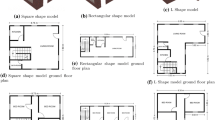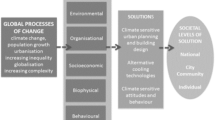Abstract
Between 2000 and 2015, annual electric peak demand in Kuwait has doubled to 15000 MW and the Ministry of Energy and Water expects this number to double once more by 2030 attributing 70% of this growth to new housing projects. Within this context, this manuscript evaluates the effect of incorporating PCM-wallboards in low-rise air-conditioned residential heavyweight buildings in Kuwait. Using an EnergyPlus single-zone model, a parametric study is performed considering several window-to-wall ratios (WWRs), different solar orientations and some PCM-wallboards configurations. The main study goals are to: (i) explore the validity of a single PCM-wallboard solution that can be universally applied throughout residential buildings in Kuwait; (ii) evaluate the impact of PCMwallboard on the reduction of both cooling demand and peak-loads; (iii) provide some guidelines for incorporating PCM-wallboards in Kuwait. Following an extensive parametric study, a 4 cm thick PCM-wallboard with a melting-peak temperature of 24 °C yielded the lowest annual cooling demand across a variety of room orientations and WWRs assuming cooling setpoint of 24 °C. Its implementation led to annual cooling energy savings of 4%–5% across all the case-studies. Regarding the impact throughout the year, cooling demand and peak-loads can be reduced by 5%–7% during summer months. The average daily cooling loads can be reduced by 5%–8%.
Similar content being viewed by others
References
Al Tayyar I (2015). Success program save energy in mew, internal presentation Kuwait Ministry of Energy and Water.
Al-ajmi FF, Hanby VI (2008). Simulation of energy consumption for Kuwaiti domestic buildings. Energy and Buildings, 40: 1101–1109.
Al-Mumin A, Khattab O, Sridhar G (2003). Occupants’ behavior and activity patterns influencing the energy consumption in the Kuwaiti residences. Energy and Buildings, 35: 549–559.
Alotaibi S (2011). Energy consumption in Kuwait: Prospects and future approaches. Energy Policy, 39: 637–643.
ANSI/ASHRAE (2004). Standard 140-2004, Standard Method of Test for the Evaluation of Building Energy Analysis Computer Programs. Atlanta, GA, USA: American Society of Heating, Refrigerating, and Air-Conditioning Engineers.
Baetens R, Jelle BP, Gustavsen A (2010). Phase change materials for building applications: A state-of-the-art review. Energy and Buildings, 42:1361–1368.
Cabeza LF, Castell A, Barreneche C, de Gracia A, Fernández AI (2011). Materials used as PCM in thermal energy storage in buildings: A review. Renewable and Sustainable Energy Reviews, 15: 1675–1695.
Cao S, Gustavsen A, Uvsløkk S, Jelle BP, Gilbert J, Maunuksela J (2010). The effect of wall-integrated phase change material panels on the indoor air and wall temperature—Hot box experiments. Paper presented at the Renewable Energy Research Conference, Trondheim, Norway.
David D, Kuznik F, Roux J-J (2011). Numerical study of the influence of the convective heat transfer on the dynamical behaviour of a phase change material wall. Applied Thermal Engineering, 31: 3117–3124.
de Gracia A, Cabeza LF (2015). Phase change materials and thermal energy storage for buildings. Energy and Buildings, 103: 414–419.
de Gracia A, Navarro L, Castell A, Cabeza LF (2015). Energy performance of a ventilated double skin facade with PCM under different climates. Energy and Buildings, 91: 37–42.
EnergyPlus (2014). EnergyPlus 8.0.0. Energy Simulation Software. Available at http://apps1.eere.energy.gov/buildings/energyplus.
Fraser M (2009). Increasing thermal mass in lightweight dwellings using phase change materials—A literature review. Built Environment Research Papers, 2(2): 69–83.
Gyptec Ibérica (2016). Tabela de preços placas de gesso e massas perfis e acessórios. Available at http://www.gyptec.eu/documentos/T_Precos_Gyptec.pdf. (in Portuguese)
Khudhair AM, Farid MM (2004). A review on energy conservation in building applications with thermal storage by latent heat using phase change materials. Energy Conversion and Management, 45: 263–275.
Kuznik F, David D, Johannes K, Roux J-J (2011). A review on phase change materials integrated in building walls. Renewable and Sustainable Energy Reviews, 15: 379–391.
Kuznik F, Virgone J (2009). Experimental investigation of wallboard containing phase change material: Data for validation of numerical modeling. Energy and Buildings, 41: 561–570.
Kuznik F, Virgone J, Johannes K (2011). In-situ study of thermal comfort enhancement in a renovated building equipped with phase change material wallboard. Renewable Energy, 36: 1458–1462.
Kuznik F, Virgone J, Noel J (2008). Optimization of a phase change material wallboard for building use. Applied Thermal Engineering, 28: 1291–1298.
Mandilaras I, Stamatiadou M, Katsourinis D, Zannis G, Founti M (2013). Experimental thermal characterization of a Mediterranean residential building with PCM gypsum board walls. Building and Environment, 61: 93–103.
Ministry of Electricity and Water (2010). Energy Conservation Program—Code of Practice, MEW, R-6, 2nd edn. Kuwait.
Osterman E, Tyagi VV, Butala V, Rahim NA, Stritih U (2012). Review of PCM based cooling technologies for buildings. Energy and Buildings, 49: 37–49.
Pomianowski M, Heiselberg P, Zhang Y (2013). Review of thermal energy storage technologies based on PCM application in buildings. Energy and Buildings, 67: 56–69.
Pullen T (2012). Homebuilding & Renovation—Phase Change Materials. Available at https://www.homebuilding.co.uk/2012/05/20/phasechange-materials.
Rae P (2014). Using Existing Governance to Make Retrofitting Enhanced Energy Efficiency into Existing Buildings, Easy. Available at http: //climatecolab.org/contests/2014/buildings/c/proposal/1309326.
Reinhart CF, Cerezo C, Jones N, Hajiah A, Al-Mumin A (2015). Kuwait 2030: A Blueprint for Managing Kuwait’s Building-related Energy Needs. Presentation to the Kuwait Foundation for the Advancement of Sciences (KFAS), Kuwait.
Saffari M, de Gracia A, Ushak S, Cabeza LF (2016). Economic impact of integrating PCM as passive system in buildings using Fanger comfort model. Energy and Buildings, 112: 159–172.
Sharma A, Tyagi VV, Chen CR, Buddhi D (2009). Review on thermal energy storage with phase change materials and applications. Renewable and Sustainable Energy Reviews, 13: 318–345.
Soares N, Costa JJ, Gaspar AR, Santos P (2013). Review of passive PCM latent heat thermal energy storage systems towards buildings’ energy efficiency. Energy and Buildings, 59: 82–103.
Soares N, Gaspar AR, Santos P, Costa JJ (2014). Multi-dimensional optimization of the incorporation of PCM-drywalls in lightweight steel-framed residential buildings in different climates. Energy and Buildings, 70: 411–421.
Tabares-Velasco P (2012). Energy impacts of nonlinear behavior of PCM when applied into building envelope. Paper presented at the ASME 6th International Conference on Energy Sustainability & 10th Fuel Cell Science, Engineering and Technology Conference, San Diego, CA, USA.
Tabares-Velasco PC, Christensen C, Bianchi M (2012). Verification and validation of EnergyPlus phase change material model for opaque wall assemblies. Building and Environment, 54: 186–196.
Tyagi VV, Buddhi D (2007). PCM thermal storage in buildings: A state of art. Renewable and Sustainable Energy Reviews, 11: 1146–1166.
Zhang Y, Zhou G, Lin K, Zhang Q, Di H (2007). Application of latent heat thermal energy storage in buildings: State-of-the-art and outlook. Building and Environment, 42: 2197–2209.
Zhou D, Zhao CY, Tian Y (2012). Review on thermal energy storage with phase change materials (PCMs) in building applications. Applied Energy, 92: 593–605.
Zhu N, Ma Z, Wang S (2009). Dynamic characteristics and energy performance of buildings using phase change materials: A review. Energy Conversion and Management, 50: 3169–3181.
Acknowledgements
The first author acknowledges the support provided by the Portuguese Foundation for Science and Technology (FCT) through the PhD scholarship SFRH/BD/51640/2011 in the framework of the MIT-Portugal program, and the support provided by FEDER funds through the COMPETE 2020 (POCI), Portugal 2020 and FCT I.P. (PIDDAC)—project “PCMs4Buildings”, ref. POCI-01-0145-FEDER-016750 (FEDER) | PTDC/EMS-ENE/6079/2014 (FCT). This work further contributed to Signature Project 1, “Sustainability of Kuwait’s Built Environment,” that was administered by the Kuwait-MIT Center for Natural Resources and the Environment.
Author information
Authors and Affiliations
Corresponding author
Rights and permissions
About this article
Cite this article
Soares, N., Reinhart, C.F. & Hajiah, A. Simulation-based analysis of the use of PCM-wallboards to reduce cooling energy demand and peak-loads in low-rise residential heavyweight buildings in Kuwait. Build. Simul. 10, 481–495 (2017). https://doi.org/10.1007/s12273-017-0347-2
Received:
Revised:
Accepted:
Published:
Issue Date:
DOI: https://doi.org/10.1007/s12273-017-0347-2




